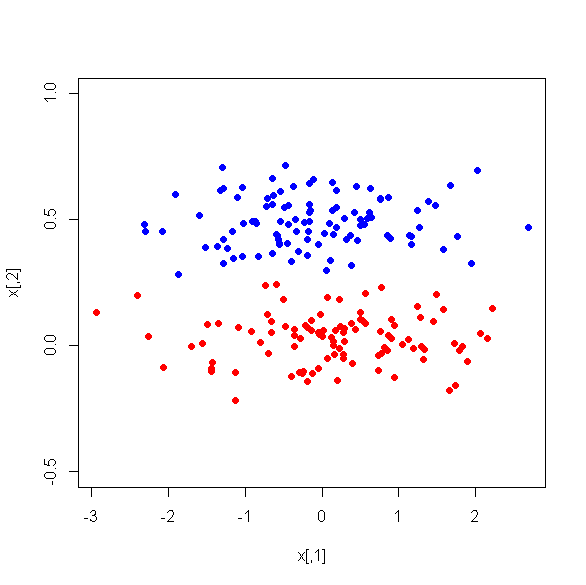Blindly using PCA is a recipe for disaster. (As an aside, automatically applying any method is not a good idea, because what works in one context is not guaranteed to work in another. We can formalize this intuitive idea with the No Free Lunch theorem.)
It's easy enough to construct an example where the eigenvectors to the smallest eigenvalues are the most informative. If you discard this data, you're discarding the most helpful information for your classification or regression problem, and your model would be improved if you had retained them.
More concretely, suppose $A$ is our $n \times p$ design matrix with $n$ observations of $p$ features, and each column is mean-centered. Then we can use SVD to compute the PCA of $A$. (see: Relationship between SVD and PCA. How to use SVD to perform PCA?)
For an example in the case of a linear model, this gives us a factorization
$$
AV = US
$$
and we wish to predict some outcome $y$ as a linear combination of the PCs: $AV\beta = y+\epsilon$ where $\epsilon$ is some noise. Further, let's assume that this linear model is the correct model.
In general, the estimated vector $\hat \beta$ can be anything. In the PCA setting where only the top $k$ components are kept, you are implicitly fixing the $\hat \beta$ coefficients of the $p-k$ discarded components to 0. In other words, even though we started out with the correct model, the truncated model is not correct because it omits the key variables.
In other words, PCA has a weakness in a supervised learning scenario because it is not "$y$-aware." Of course, in the cases where PCA is a helpful step, then $\beta$ will have nonzero entries corresponding to the larger singular values.
I think this example is instructive because it shows that even in the special case that the model is linear, truncating $AV$ risks discarding information.
You can even generate data where the discarded components are essential. Create 2 independent features, one that's completely random, and one that perfectly predicts the outcome, but has a smaller variance. Using PCA & keeping $k=1$ components will fail. Moreover, the smaller the variance of the informative feature, the more pronounced this effect will be.

This illustration comes from this answer https://stats.stackexchange.com/a/80450/22311 with my thanks to Flounderer.
This class implements a simple demonstration. It randomly generates data according to my scheme, and then applies PCA, retaining the desired number of features. Then it tunes an SVM classifier and reports the AUC.
class PcaSvm(object):
def __init__(self, seed):
self.seed = seed
self.rng = np.random.default_rng(seed)
def __call__(self, a, k, sample_size=1000):
# x1 is uninformative & has standard deviation = 1
x1 = self.rng.standard_normal(sample_size).reshape((-1, 1))
# x1 is very informative & has standard deviation = a
x2 = a * self.rng.standard_normal(sample_size).reshape((-1, 1))
# y strongly depends on x2; some samples will be perfectly separable or nearly so
y = self.rng.binomial(n=1, p=expit(1e6 * np.sign(x2))).reshape(-1)
svc_params = {
"svc__C": stats.loguniform(1e0, 1e3),
"svc__gamma": stats.loguniform(1e-4, 1e-2),
}
clf = sklearn.pipeline.make_pipeline(
PCA(n_components=k), StandardScaler(), SVC()
)
random_search = RandomizedSearchCV(
clf,
param_distributions=svc_params,
n_iter=60,
scoring="roc_auc",
random_state=self.seed,
)
random_search.fit(np.hstack([x1, x2]), y)
best_test_auc = random_search.cv_results_["mean_test_score"].max()
print(
f"Using a={a}, the best model with k={k} PCA components has an average AUC (on the test set) of {best_test_auc:.4f}"
)
When PCA only retains 1 feature, the model is somewhere between worthless and mediocre. When retaining 2 features, the model is literally perfect.
| standard deviation of informative feature |
number of components retained |
AUC |
| 0.001 |
1 |
0.5024 |
| 0.1 |
1 |
0.5075 |
| 0.9 |
1 |
0.5197 |
| 1.0 |
1 |
0.7277 |
| 0.001 |
2 |
1.0 |
| 0.1 |
2 |
1.0 |
| 0.9 |
2 |
1.0 |
| 1.0 |
2 |
1.0 |
Other common objections to "always" using PCA include:
PCA is a linear model, but the relationships among features may not have the form of a linear factorization. This implies that PCA will be a distortion.
PCA can be hard to interpret, because it tends to yield "dense" factorizations, where all features in $A$ have nonzero effect on each PC.
We also have a few related threads (thanks, @gung!):

